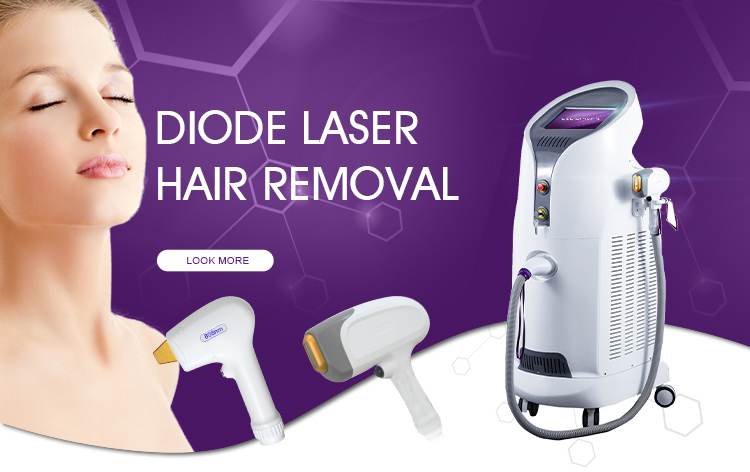
In the realm of professional laser hair removal technologies, as highlighted in our discussion on the six types of laser hair removal machines, the diode laser stands out as one of the most popular choices. Its effectiveness, versatility in treating various skin tones and hair colors, rejuvenating skin properties, and the speed of treatments contribute significantly to its appeal.
Moreover, the diode laser excels at effectively targeting coarse, thick, and stubborn hair, making it a preferred option for individuals seeking the most efficient results in managing their rapidly growing unwanted hair. Therefore, if you are considering diode laser hair removal and wish to gather more insights about the procedure, you have come to the right place.
Let’s explore everything you need to know about diode laser hair removal.
Table of Contents:
Part 1: What is Diode Laser Hair Removal?

Similar to other laser hair removal techniques, diode laser technology operates based on the principle of selective photothermolysis. This means that the laser's radiation is absorbed by the melanin in the hair, while the surrounding skin remains unharmed.
A key advantage of diode lasers is their efficacy for darker skin tones, as well as their superior performance on dark, terminal, and coarse hair. Operating with a wavelength range from 700 nm to 1100 nm, this technology allows for deeper skin penetration and quicker targeting of stubborn hair follicles.
Additionally, clinical studies have demonstrated that utilizing three wavelengths of diode lasers effectively reduces unwanted hair on the face, chest, limbs, and various other body areas in individuals with skin types IV and V [1].
Part 2: Is Diode Laser Hair Removal Effective?
To achieve noticeable results with diode laser hair removal, multiple treatment sessions are typically required. Upon completion of these sessions, many individuals report a significant reduction in hair growth. Research conducted in Poland and the UK has confirmed that the 805 nm diode laser effectively combats unwanted body hair [1].
Not only is this method effective for hair removal, but it also offers long-lasting results lasting several months, or even up to a year or more [2]. However, individual outcomes can vary based on several factors:
Ulike Air 10 IPL
SUMMER SALE
The most valuable IPL device available today.
$399.00
Shop Now - $80 OFF
Read the full review
Part 3: How Many Sessions Are Needed for Diode Laser Hair Removal?
Like other laser treatments, diode laser hair removal typically requires more than one session to effectively target and eliminate hair. On average, individuals may need between 6 to 10 sessions, depending on various factors.
Part 4: Diode Laser Hair Removal vs. Alexandrite Laser Hair Removal
The Alexandrite laser operates at a wavelength of 755 nm, while the diode laser has a wavelength of 810 nm. This deeper penetration capability of the diode laser makes it a safer option for individuals with darker skin types [3]. Alexandrite lasers, on the other hand, are better suited for lighter skin tones.
While diode lasers may be perceived as more painful, they have demonstrated effectiveness in treating coarse hair, whereas Alexandrite lasers excel in managing finer hair. Additionally, Alexandrite technology employs a combination of minerals, whereas diode lasers utilize two layers of semiconductors, with gallium arsenide serving as the active component. This distinction often results in Alexandrite treatments being more expensive.
Part 5: Diode Laser Hair Removal vs. IPL (Intense Pulsed Light)
Diode laser hair removaldiode laser treatment
In terms of wavelength, IPL utilizes broad-spectrum light rays ranging from 500 to 1200 nm, while diode lasers use monochromatic light within the 700 to 1400 nm range. The extended wavelength of diode lasers allows for deeper penetration, which is advantageous for treating brown and black hair colors, as opposed to IPL, which is more suitable for lighter skin tones.
Moreover, diode lasers are particularly effective on terminal hair, whereas IPL can be applied to any hair type with pigmentation. Therefore, it is essential to consider your skin tone, hair type, and budget when choosing between these two laser hair removal options. You can explore the best IPL hair removal machines available here.
Part 6: Diode Laser Hair Removal Machines
1. Tria Hair Removal Laser 4X
This device features a compact round window that emits 20 J/cm² of energy, operates wirelessly with rechargeable capabilities, and offers five intensity levels. The Tria Hair Removal 4X is an excellent option for individuals looking to perform hair removal treatments at home.
Furthermore, it is FDA-cleared and effectively slows hair growth, promoting long-lasting hair removal results [6].
2. ELYSION-PRO Diode Laser Hair Removal System
The Elysion-Pro diode laser hair removal system incorporates four wavelengths, enabling professionals to address a wide range of skin tones and hair colors. It holds both FDA and European medical certifications and provides consistent flashes of light for precise targeting.
3. Soprano Laser Hair Removal System
This system features three wavelengths and an integrated cooling technology, making it one of the top devices in professional hair removal clinics. It is suitable for all skin tones and hair types, including fine to coarse hair, and is effective even on tanned skin, with minimal downtime required.
4. Filfeel Portable 808 Diode Laser Hair Removal Machine
The Fil






































